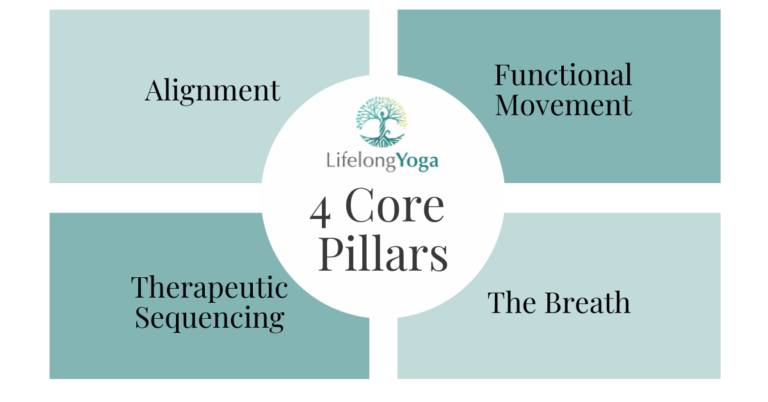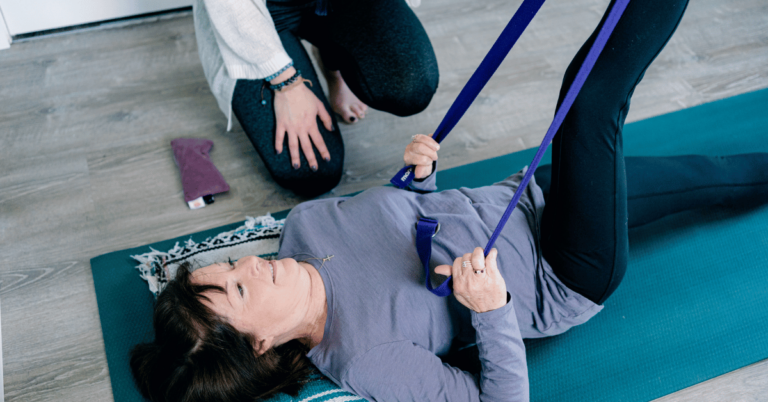Yoga for Lupus: A Complete Guide to Safe and Effective Practice

Recently, a student asked me if yoga could help her friend who has lupus. (Spoiler alert: yes, it can!)
As I started sharing my thoughts, I realized this topic deserved more than a quick response – there was so much I wanted to say about how yoga can support people living with autoimmune conditions that I decided to turn my answer into this blog post.
I’ll share specific practices for different lupus symptoms shortly, but first, there’s something important to understand: when it comes to lupus – or any chronic condition – we need to let go of the idea that there’s a single ‘right’ way to practice.
Because lupus is known for its unpredictability – some days might bring more joint pain, others might bring fatigue, and some days might feel relatively symptom-free. A yoga practice that worked perfectly yesterday might not serve you at all today.
This is exactly why I believe that following a cookie-cutter approach to yoga can be counterproductive – or even harmful – when living with lupus. Instead, we need to develop a flexible, adaptive practice that can meet us wherever we are on any given day. Some days that might mean a gentle standing sequence, other days it might mean practicing entirely in a chair, and during flares, it might mean focusing solely on breath work and meditation.
How yoga can help people with lupus
While I’m focusing on lupus here, much of what I’m sharing applies to other autoimmune conditions like rheumatoid arthritis and MS – conditions where symptoms can vary greatly from day to day and person to person. This is where the mindful, adaptable nature of yoga becomes so valuable.
Yoga can offer several benefits for people with lupus and other autoimmune conditions:
- Gentle movement that maintains joint mobility without strain
- Stress reduction (which can help manage flares)
- Better sleep quality
- Improved breath awareness
- A sense of agency over your wellbeing
This isn’t just anecdotal evidence, by the way. Research has shown that yoga can be both safe and beneficial for people with lupus, helping to reduce fatigue without aggravating symptoms. Studies indicate that elements of yoga – from gentle movement to slow breathing and meditation – can help activate the parasympathetic nervous system, supporting rest, immunity, and overall wellbeing.
Best yoga practices for managing lupus symptoms
Living with lupus often means managing multiple symptoms. Here’s how specific yoga practices can help with each:
For joint pain and stiffness
Gentle range-of-motion movements help maintain joint mobility without causing stress. Simple practices like wrist and ankle circles, shoulder rolls, and supported stretches can help ease morning stiffness and maintain function. The key is moving slowly and mindfully, never pushing into pain.
Practices to try:
For fatigue
While it might seem counterintuitive, specific types of gentle movement can actually help manage fatigue. For example, restorative poses, where the body is fully supported by props, allow for deep rest while maintaining healthy circulation. Even simple breathing practices can help boost energy levels without depleting your resources.
Practices to try:
For stress & anxiety
The breath awareness we practice in yoga has a direct impact on our nervous system. Long, slow exhales help activate our parasympathetic nervous system (our rest-and-digest mode), which is particularly important since stress can trigger lupus flares. Research shows that this shift from “high-alert” mode to a more restful state can be especially beneficial during flare periods. Simple meditation and guided relaxation techniques can help manage the emotional challenges of living with a chronic condition.
Practices to try:
For sleep issues
A gentle bedtime yoga routine can help prepare both body and mind for rest. Calming forward folds (seated or supported), quiet twists, and relaxation practices can improve sleep quality – which is important for managing lupus symptoms.
Practices to try:
For muscle weakness
Holding gentle poses for short periods helps maintain muscle strength without overtaxing the body. Props like chairs, walls, and blocks provide support while you work on building stability. This is especially important since some lupus medications can affect muscle strength.
Practices to try:
For circulation
Slow, mindful movement through the joints and gentle inversions (like legs up the wall) can help improve circulation without stressing the body. This can be particularly beneficial for managing Raynaud’s phenomenon, which often accompanies lupus.
Practices to try:
For brain fog
The mindfulness aspect of yoga – focusing on breath and body awareness – can help improve mental clarity. Simple balance poses (always with support nearby) help sharpen focus while building physical stability.
Practices to try:
Best yoga styles and approaches for lupus
Here’s what I’ve learned as a yoga therapist about supporting students with autoimmune conditions: gentler is usually better. While you might see lots of dynamic, more intense yoga styles on social media, these aren’t typically the best choice when living with lupus.
Instead, consider approaches that emphasize:
- Mindful movement
- Proper alignment
- Use of props for support
- Longer holds when comfortable
- Plenty of rest between poses
Traditional Hatha yoga, Iyengar yoga, and Restorative yoga all offer elements that can be beneficial. This is actually one reason I love the Lifelong Yoga approach – it thoughtfully combines elements from these traditions, creating a practice that’s both therapeutic and adaptable to your needs each day.
What to be mindful of when practicing yoga with lupus
Just as important as knowing what to do is knowing what to avoid. High-intensity practices or hot yoga typically aren’t recommended for people with lupus. These can trigger flares and create unnecessary stress on the body.
Also, be cautious with:
- Pushing through fatigue
- Attempting the more challenging balance postures during a flare
- Complex sequences that might create stress about “keeping up”
- Practices that don’t allow for modification or rest
A final note
What I most want to emphasize is this: yoga isn’t about achieving perfect poses or pushing through discomfort. It’s about creating a practice that supports you exactly as you are, day by day. With lupus, that means being especially mindful and gentle with yourself, celebrating what your body can do while respecting its limits.
Remember, the goal isn’t to “conquer” yoga – it’s to use yoga as a tool for better living with lupus. Sometimes the most powerful practice is the gentlest one.
Living with lupus or another autoimmune condition? Have you tried yoga? If so, how do you adapt your movement practice to support your wellbeing? Share your experiences in the comments below; I’d love to hear from you.






